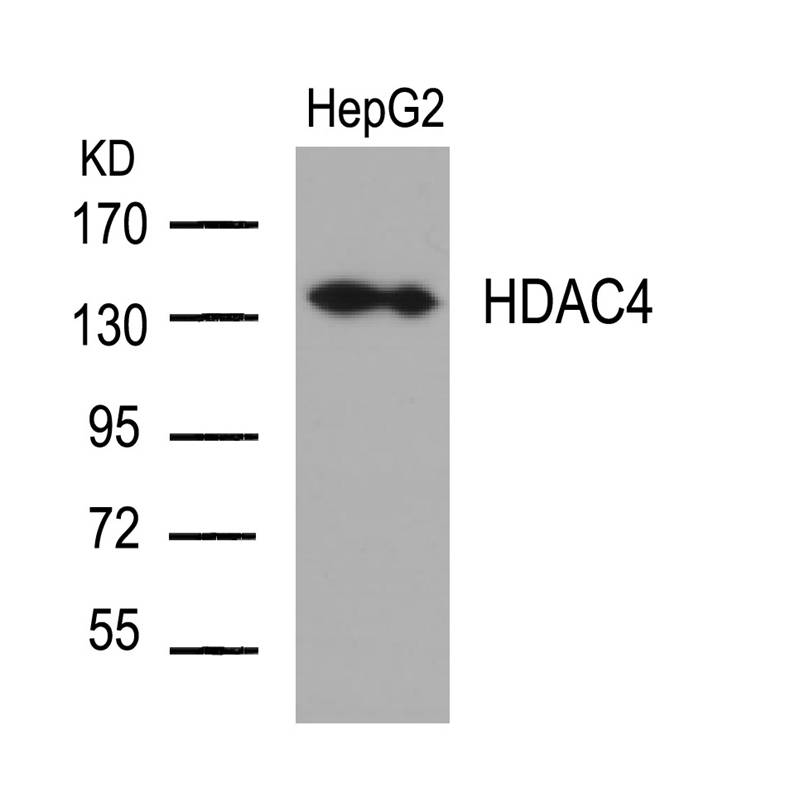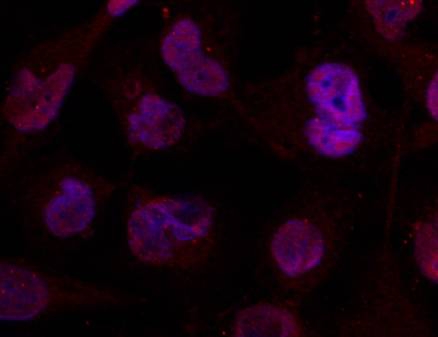

| WB | 咨询技术 | Human,Mouse,Rat |
| IF | 咨询技术 | Human,Mouse,Rat |
| IHC | 咨询技术 | Human,Mouse,Rat |
| ICC | 1/100-1/200 | Human,Mouse,Rat |
| FCM | 咨询技术 | Human,Mouse,Rat |
| Elisa | 咨询技术 | Human,Mouse,Rat |
| Aliases | HD4; Histone deacetylase 4; |
| Entrez GeneID | 9759; |
| WB Predicted band size | 140kDa |
| Host/Isotype | Rabbit IgG |
| Antibody Type | Primary antibody |
| Storage | Store at 4°C short term. Aliquot and store at -20°C long term. Avoid freeze/thaw cycles. |
| Species Reactivity | Human,Mouse,Rat |
| Immunogen | Peptide sequence around aa. 630~634 (A-Q-S-S-P) derived from Human HDAC4. |
| Formulation | Purified antibody in PBS with 0.05% sodium azide. |
+ +
以下是关于HDAC4(磷酸化位点Ser632.可能对应Ab-632抗体)的3篇相关文献,内容涵盖其功能及机制研究:
---
1. **文献名称**:*HDAC4 governs a transcriptional program essential for synaptic plasticity and memory*
**作者**:Sando R et al.
**摘要**:该研究揭示了HDAC4在神经元突触可塑性和记忆形成中的关键作用。通过磷酸化位点Ser632的修饰,HDAC4的核质穿梭受到CaMKII信号调控,进而影响下游基因(如脑源性神经营养因子BDNF)的表达,最终调控海马依赖的学习记忆功能。
---
2. **文献名称**:*Phosphorylation of HDAC4 by PKA modulates transcriptional repression in vascular smooth muscle cells*
**作者**:Backs J et al.
**摘要**:研究发现,蛋白激酶A(PKA)对HDAC4 Ser632位点的磷酸化可阻断其与MEF2转录因子的结合,导致HDAC4从细胞核转位至胞质。此过程解除对促分化基因的抑制,从而在血管平滑肌细胞表型转化中起关键作用。
---
3. **文献名称**:*Regulation of HDAC4 nuclear localization by 14-3-3 proteins in muscular dystrophy*
**作者**:Miska EA et al.
**摘要**:该文献阐明,在肌肉萎缩疾病模型中,HDAC4的Ser632磷酸化促进其与14-3-3蛋白结合,导致HDAC4滞留于胞质中,无法抑制核内肌肉特异性基因(如肌球蛋白重链)的表达,从而缓解肌肉萎缩进程。
---
**备注**:以上文献为HDAC4 Ser632磷酸化相关机制的示例研究,具体抗体Ab-632的应用需结合实验背景(如厂商提供的引用文献)进一步确认。
The HDAC4(Ab-632) antibody is a monoclonal antibody specifically designed to detect histone deacetylase 4 (HDAC4), a member of the class IIa HDAC family. HDAC4 plays a critical role in epigenetic regulation by catalyzing the removal of acetyl groups from histone lysine residues, leading to chromatin condensation and transcriptional repression. This antibody targets a phosphorylated epitope at serine 632 (Ser632) of human HDAC4. a post-translational modification associated with subcellular localization and functional regulation. Phosphorylation at Ser632 facilitates cytoplasmic retention of HDAC4. preventing its nuclear translocation and interaction with transcription factors like MEF2. which is essential for modulating gene expression in processes such as muscle differentiation, neuronal survival, and bone development.
HDAC4(Ab-632) is commonly used in applications like Western blotting, immunohistochemistry, and immunoprecipitation to study HDAC4’s role in cellular signaling, disease mechanisms (e.g., cancer, neurodegeneration), and response to therapeutic HDAC inhibitors. Its specificity for the phosphorylated form makes it valuable for investigating HDAC4 regulation under diverse physiological or pathological conditions, such as stress signaling or metabolic disorders. Validation typically includes reactivity with human, mouse, and rat samples, with cross-reactivity checks against related HDAC family members to ensure minimal off-target binding. Proper storage conditions (e.g., -20°C in aliquots) are recommended to maintain antibody stability.
×